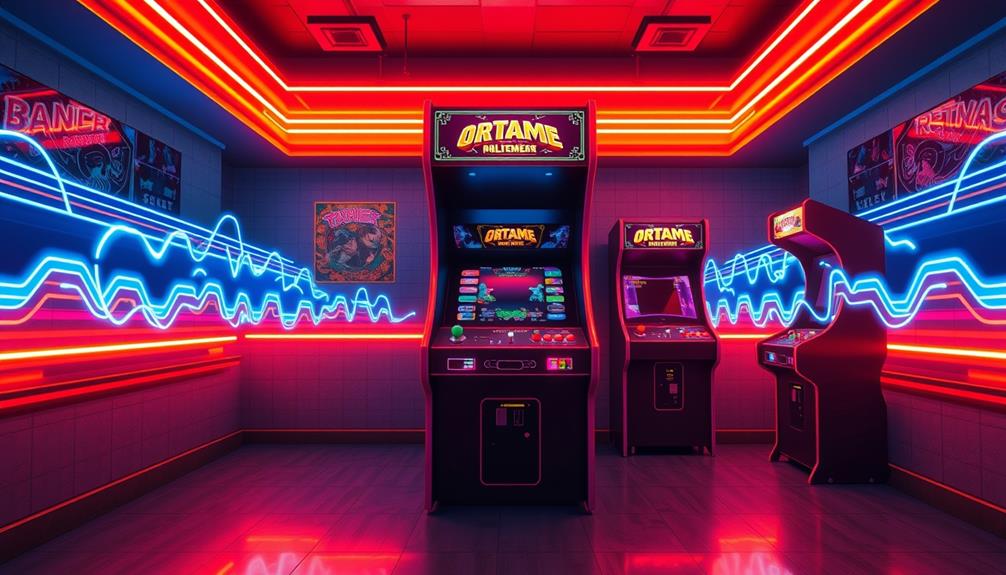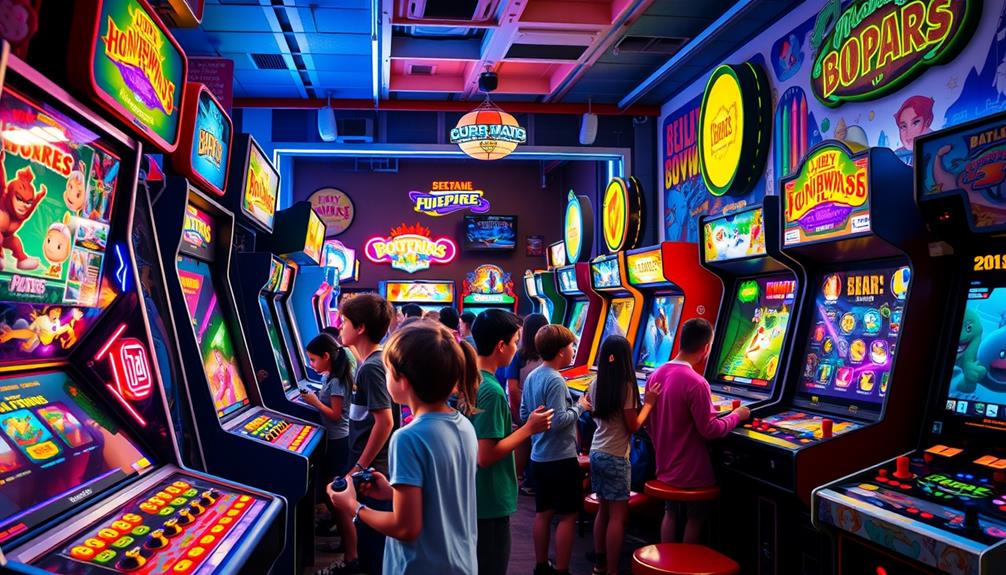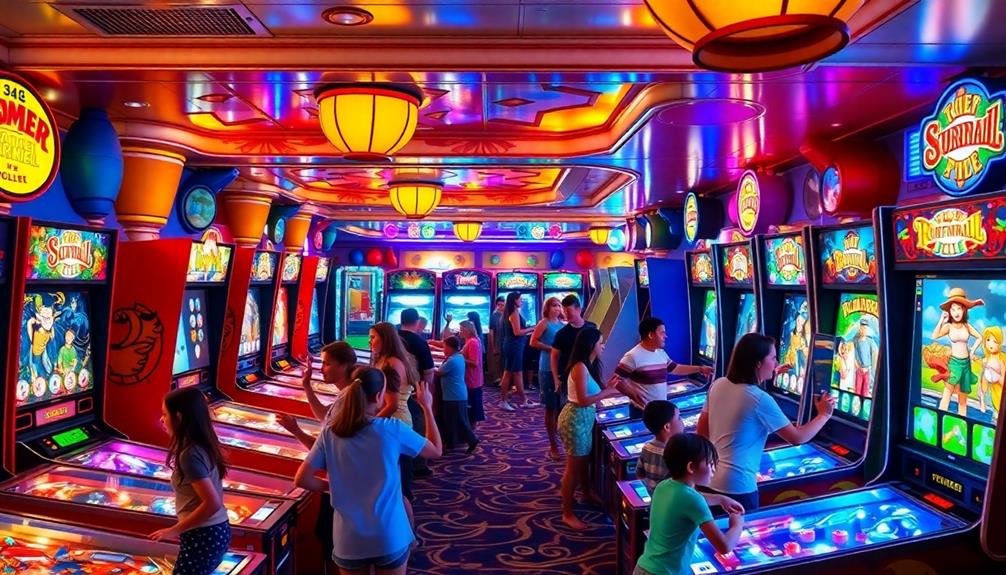In 1980, arcade games that changed the way players engaged and interacted were prevalent. Games like Pac-Man introduced power-ups, while Phoenix introduced the first Boss character, adding strategy and humor. The iconic graphics and sound enhanced the gameplay experience and appealed to a wider audience. Multiplayer features, as seen in Wizard of Wor and Battlezone, turned arcades into social gathering places, bringing players together. This year saw a significant increase in revenue for the industry. If you are interested in learning more about how these innovations influenced gaming culture, there is much more to discover about this important year in arcade history.
Key Takeaways
- Introduction of the first-ever Boss character in *Phoenix*, adding strategic depth to gameplay.
- *Defender* featured dual joystick controls and horizontally scrolling shooter mechanics, enhancing player experience.
- *Pac-Man* introduced engaging power-ups, creating a new layer of strategy and player interaction.
- *Battlezone* utilized vector graphics for immersive first-person tank battles, showcasing advanced visual technology.
- Multiplayer features in games like *Wizard of Wor* transformed arcades into social hubs for community engagement.
New Gameplay Mechanics
In the domain of arcade gaming, 1980 marked a turning point with innovations that transformed how players engaged with their screens. You'd find new gameplay mechanics that added depth and excitement to your gaming experience.
For instance, Phoenix introduced the first-ever Boss character, challenging you to strategize and adapt as you faced increasingly complex foes. This year also saw an increase in competitive play, akin to the excitement found in top-rated pinball games, as players aimed for high scores and bragging rights.
Meanwhile, Defender revolutionized the genre with its horizontally scrolling shooter mechanics, allowing you to navigate the action using dual joysticks, which provided a level of control that was previously unmatched. The unique Reverse button also encouraged strategic play, as you could maneuver in ways that kept opponents guessing.
Battlezone took things further with its stunning vector graphics, immersing you in a first-person perspective tank battle that was visually groundbreaking for the time.
Power-ups, featured in games like Pac-Man, allowed you to temporarily gain advantages, such as devouring ghosts, enhancing your strategic choices.
Additionally, multiplayer features emerged in titles like Wizard of Wor, making arcade gaming a more social experience as you teamed up with friends. These mechanics revolutionized how you played, setting the stage for future innovations.
Iconic Game Releases

As 1980 unfolded, gamers were treated to a wave of iconic releases that would shape the landscape of arcade gaming. *Pac-Man* emerged as a cultural phenomenon, introducing players to its charming non-violent mascot and engaging power-up mechanics that appealed to a diverse audience. Its success marked a significant turning point for arcade video games, inviting players of all ages to join in and fostering a sense of community, much like the dynamic friendships seen among celebrities today.
Following *Pac-Man*, *Defender* made its debut as the first arcade game featuring a horizontally scrolling shooter format. Its complex control scheme required players to navigate and rescue characters from alien abductions, delivering a unique gameplay experience.
Meanwhile, *Phoenix* innovated by introducing the first-ever Boss character, enhancing strategic gameplay and adding a touch of humor to the mix. The immersive experience of *Battlezone* utilized vector graphics to create 3D tank battles, while its dual-joystick control scheme allowed for a more dynamic approach to gameplay.
Enhanced Graphics and Sound

While arcade games in 1980 embraced a more vibrant aesthetic, they also revolutionized the audio experience, enchanting players like never before. You'd notice how titles like Pac-Man introduced cartoonish graphics that appealed to a broader audience, marking a significant shift from the pixelated visuals of the past.
With technicolor visuals in games like Galaxian, you found yourself immersed in an environment that felt alive and dynamic, vastly improving the visual experience over earlier monochrome titles. This era of gaming also saw a growing appreciation for uplifting music that complemented the lively graphics and enhanced overall gameplay.
But it wasn't just about the graphics. Sound effects took center stage, with games like Asteroids featuring 13 unique sound effects crafted through custom hardware circuits. This innovation helped deepen gameplay immersion.
You'd hear synthesized sounds in Phoenix, where engaging gameplay combined with humorous audio cues made every session enjoyable.
Additionally, many 1980 arcade games began to incorporate background music and thematic audio elements, enriching the overall atmosphere. The result? An engaging gameplay experience that pulled you in, making you feel part of the action.
Multiplayer Features

Building on the engaging graphics and sound, multiplayer features began to redefine the arcade experience in 1980. Games like *Wizard of Wor* introduced multiplayer gameplay, allowing you to team up with a friend to navigate mazes and defeat enemies, enhancing social interaction. Meanwhile, *Battlezone* offered competitive play, where you could challenge a friend in intense tank battles, using strategy to outmaneuver your opponent.
*Phoenix* also made waves by encouraging players to compete for high scores while battling waves of enemies, creating a camaraderie among gamers. Even *Pac-Man*, known for its solo gameplay, adapted by allowing players to take turns, fostering a shared gaming experience.
These innovations not only enhanced the fun but also contributed to the popularity of arcade venues during the Golden Age of Arcade.
| Game Title | Multiplayer Feature |
|---|---|
| Wizard of Wor | Cooperative gameplay |
| Battlezone | Competitive tank battles |
| Phoenix | High score competition |
Incorporating these multiplayer features transformed the arcade into a vibrant social hub, where friendly rivalries and teamwork thrived, making gaming a communal experience.
Financial Impact on Industry

The financial impact of arcade games in 1980 was nothing short of remarkable, with the U.S. market generating an astounding $2.81 billion in revenue. This figure, when adjusted for inflation, climbs to about $10.4 billion, showcasing significant market growth.
The introduction of iconic titles transformed the landscape of video games and their profitability, much like how diversification is essential for managing financial investments. Key factors contributing to this surge included:
- *Pac-Man* became the highest-grossing arcade game of all time, attracting diverse audiences and driving sales.
- *Asteroids* alone generated around $500 million for arcade operators, emphasizing its popularity.
- The annual arcade revenue saw a staggering 300% increase compared to 1979, largely due to innovative game design.
- By 1980, Japan boasted over 300,000 arcade machines, highlighting the booming demand for games.
These developments not only shaped the financial landscape but also set the stage for future innovations in arcade gaming.
As you can see, the financial impact of arcade games in 1980 laid a solid foundation for the industry, creating a ripple effect that would influence gaming for years to come.
Cultural Significance

Arcade games in 1980 didn't just reshape the financial landscape; they also made a significant cultural impact. The release of *Pac-Man* marked the emergence of a cultural phenomenon, introducing non-violent gameplay that attracted a wider audience, including many female gamers. This shift in focus encouraged other developers to create games with mascot characters and approachable themes.
The influence of arcade games extended beyond mere entertainment, as they became a part of the broader cultural dialogue and social interactions, much like how luxury cruises provide exclusive amenities during travel experiences.
*Pac-Man* didn't just stop at being a game; it became a franchise that spawned merchandise, television shows, and even music, showcasing its widespread influence. The introduction of power-ups in games like *Pac-Man* and *Phoenix* added strategic elements, enhancing player engagement and fostering competitive high-score chasing among friends.
The arcade scene itself transformed into a vibrant social hub where diverse groups came together. This community engagement around gaming culture solidified arcades as essential entertainment venues.
Games like *Defender* and *Battlezone* set new standards for player interaction, pushing boundaries in immersive experiences. Overall, the cultural significance of arcade games in 1980 is undeniable, as they not only entertained but also shaped social dynamics and conversations around gaming.
Legacy and Influence

In 1980, arcade games began a legacy that continues to influence the gaming industry today. The introduction of *Pac-Man* not only popularized maze chase gameplay but also opened the doors for a broader demographic, including female gamers. This shift fundamentally changed the audience for arcade games.
Key elements established during this period laid the groundwork for modern gaming:
- *Pac-Man* introduced strategic power-ups, enhancing engagement and gameplay mechanics, which is reminiscent of how astrology and attractiveness influence personal charm.
- *Defender* pioneered dual-joystick controls, emphasizing player skill and strategy, which influenced future arcade shooters.
- The rise of multiplayer games like *Wizard of Wor* encouraged social interaction, leading to a focus on cooperative gameplay.
- The financial success of arcade games, with annual revenues hitting $2.8 billion, solidified the arcade model as a mainstream entertainment option, shaping future game design and marketing strategies.
These innovations not only set standards for gameplay and strategy but also created a foundation that modern games still build upon.
The legacy of 1980 remains vibrant, continuing to inspire game developers and engage players around the world.
Frequently Asked Questions
Why Were Arcades Such a Big Hit in the 1980S?
Arcades became a hit in the 1980s because you enjoyed innovative games, bright graphics, and engaging sound. They offered social spaces for competition, attracting diverse players enthusiastic to connect and challenge each other. Popular arcade games from the 80s such as Pac-Man, Space Invaders, and Donkey Kong captured the imagination of a generation and became instant classics. Their simple yet addictive gameplay, combined with the thrill of high scores, kept players coming back for more. The rise of arcades in the 1980s marked a cultural shift towards interactive entertainment and paved the way for the modern gaming industry as we know it today. Popular arcade games in the 80s also introduced new technology, such as the use of microprocessors and advanced graphics, which enhanced the gaming experience. Titles like Galaga, Frogger, and Centipede showcased the capabilities of these advancements, solidifying their status as iconic games in the history of arcade gaming. The popularity of these games in the 80s not only defined a generation but also laid the foundation for the evolution of gaming into the immersive and interactive form we see today.
Which Video Arcade Game Was #1 in the Year 1980?
Imagine a golden maze where you chase dreams, dodging shadows. In 1980, *Pac-Man* reigned supreme, enchanting players with its vibrant world and clever strategies. You couldn't resist the thrill of gobbling up those elusive ghosts.
Which 1980S Arcade Game Appealed to Almost Everyone?
In the 1980s, you'd find Pac-Man appealing to almost everyone. Its colorful graphics, non-violent gameplay, and engaging maze navigation attracted both casual and dedicated players, making it a cultural icon in gaming history.
How Much Did It Cost to Play Arcade Games in the 80S?
In the 80s, playing arcade games typically cost you around 25 cents. Some popular titles could charge up to 50 cents, while bulk token purchases often offered savings, making gaming more accessible and fun for everyone.
Conclusion
In 1980, arcade games transformed into vibrant canvases, painting new worlds with innovative mechanics and unforgettable characters. You can see how titles like "Pac-Man" became cultural icons, symbolizing the dawn of a gaming revolution. As multiplayer features sparked social connections, the industry thrived, echoing the pulse of a generation. This era didn't just change how you play; it set the stage for future adventures, reminding you that every pixel holds a piece of history waiting to be explored.









